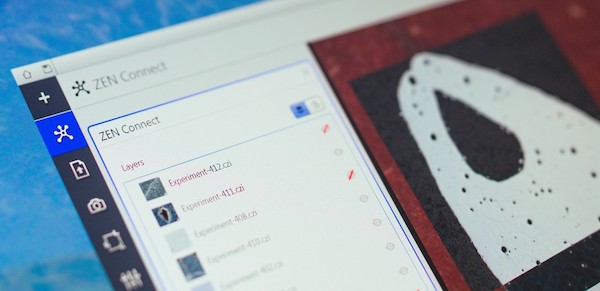Organizing Images from any Source to Connect Multi-Modal Data
ZEISS ZEN Connect for the materials research lab
ZEISS ZEN Connect software module is now available for materials researchers at universities, multi-user facilities or industrial labs. It enables users to bring all imaging technologies together – ZEISS or otherwise – to answer their questions.
Gaining unique insights and saving time
ZEISS ZEN Connect allows users to align and overlay images from any source. Researchers can use the workflow of ZEISS ZEN Connect to go from a quick overview image in a light microscope to advanced imaging with a high resolution system. The overview image for navigation and all subsequent images will automatically be shown in context. The multi-modal data is then saved in well-organized projects with intuitive image labels.
Correlative Workspace
The Correlative Workspace makes it possible to zoom in from the full macroscopic view of the sample down to nanoscale details. A comprehensive, sample-centric correlative environment handles multi-scale and multi-modal images.
Smart Data Management
As digitization continues to improve microscopic investigations, users are facing an ever-growing mass of images and data that needs to be managed, especially in multi-user laboratories. ZEISS ZEN Connect supports various image formats: CZI, TIF, JPG, BMP, RAW, and many more. ZEISS ZEN Data Storage separates image and data acquisition from post-acquisition works, making everyone in the lab work more efficiently.
Materials research in various areas benefits from ZEISS ZEN Connect
When users aim to characterize the properties of their sample comprehensively, they need to combine multiple microscopy modalities or contrasting techniques.
For example, the future of e-mobility depends on gaining a better understanding of permanent magnets. Researchers can draw conclusions about the correlation between sample morphology and magnetic parameters. By imaging large regions with a light microscope and additionally visualizing magnetic domains with Kerr microscopy, they are able to identify promising magnetic phases. Using an electron microscope, nanometer-scaled features become visible and provide a deeper understanding of the morphology of these phases. Detected features are connected across length scales and imaging modalities.
Furthermore, materials research on e.g. inclusions in calcium-treated steel, oil recovery, or carbon capture and storage also benefits from ZEISS ZEN Connect’s capability of bringing multi-modal microscopy techniques together. Research on e.g. the anisotropy of steel is facilitated by permitting access to imaging and analytical data in order to correlate morphology to chemical composition and thus gain a better understanding of the materials’ properties. Geoscientists who investigate carbonate rocks profit from insights into pore structure and volume at different scales. ZEISS ZEN Connect links data to context at all times during these experiments.

